You may be able to improve your postural muscles over time with a combination of yoga, stretching, and exercises to build your strength.
Thanks to gravity, our feet are well grounded. But the efforts of not completely face planting? We owe that to our postural muscles.
At our muscle’s peak, they prevent our bones and ligaments from being stressed, strained, and jutting out of alignment. More magic our postural muscles are responsible for? Keeping our heads upright and minds well.
But between crossing our legs and Netflix marathons, the relationship we have with postural muscles may have flickered out over time, leaving our bodies at risk for spinal wear and tear and chronic pain.
Getting that perfect spine back isn’t going to be a quick fix. You’ll need consistency, awareness, and dedication — virtues you can develop with this “Every Woman’s Guide to Better Posture in 30 Days.”
Over the next 30 days, these movements and exercises will help you:
- loosen up muscles
- increase body awareness
- strengthen your core
- realign your body’s joints
Save or print out the calendar below to remind yourself what to do.
It will cover which exercises to do (these will take up 8 to 20 minutes of your day) and routine reminders that’ll activate your muscle memory to keep your posture in check, long after you master the guide.

Read on for detailed instructions and a how-to guide on performing each exercise.
Building the foundation to great posture
This week is about learning new poses and exercises and using them to develop what is called an “Awareness Routine.”
Learn poses that will help you lengthen your spine and release any tension you may have built up over the last few years.
Day 1: Do a posture check
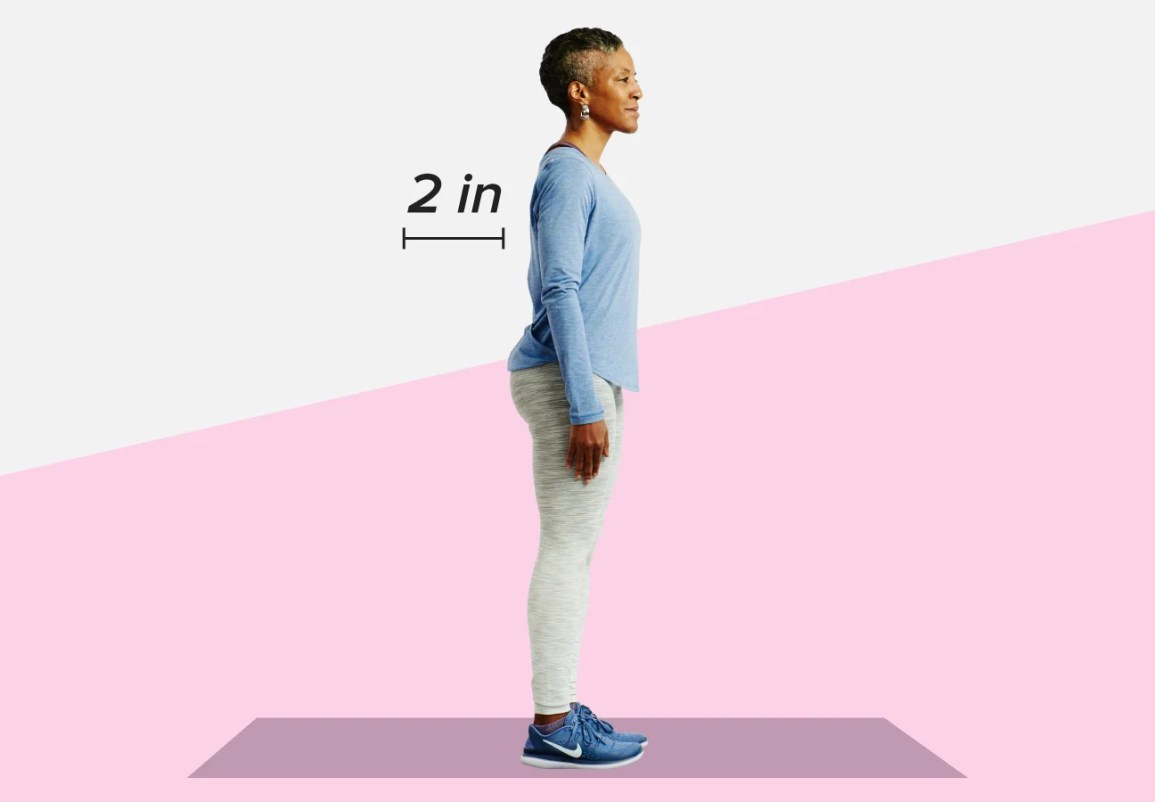
Stand against a wall to check your posture. You should have less than 2 inches between the wall and your neck and back. Keep this position in mind as you go throughout the rest of your day, checking in at every hour.
According to Dr. Austin Davis of Life Chiropractic SF, when it comes to posture, awareness is what’s most important.
How to do a posture check:
- Stand with the back of your head against the wall and place your heels 6 inches from the wall. Your shoulder blades and butt should be touching the wall.
- Measure the space between your neck and the wall, and the space between your lower back and the wall. There should be less than 2 inches between both spaces. A larger gap indicates impaired posture.
Day 2: Do Child’s Pose
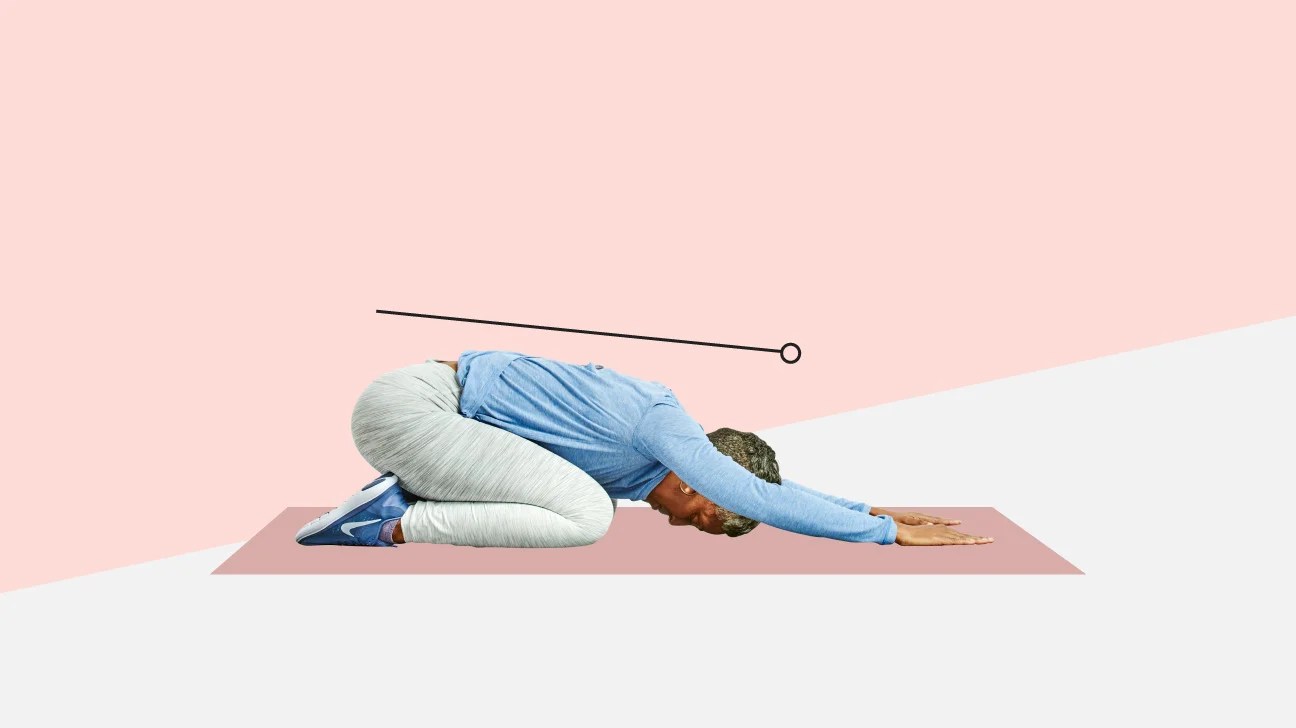
Do 5 minutes of Child’s Pose, morning and night. Child’s Pose helps lengthen and stretch the spine, which is used to slouching after years of bad posture.
How to do Child’s Pose:
- Start on your hands and knees, with your knees as far as shoulders-width apart and big toes touching each other.
- Crawl forward on your hands and extend your arms straight out toward the front of the mat. You can also drape your arms on the floor alongside your body.
- Slowly start to drop your hips back to rest on your heels.
- Rest your forehead on the floor.
- Breathe here for 5–10 deep breaths.
Day 3: Add Standing Forward Fold
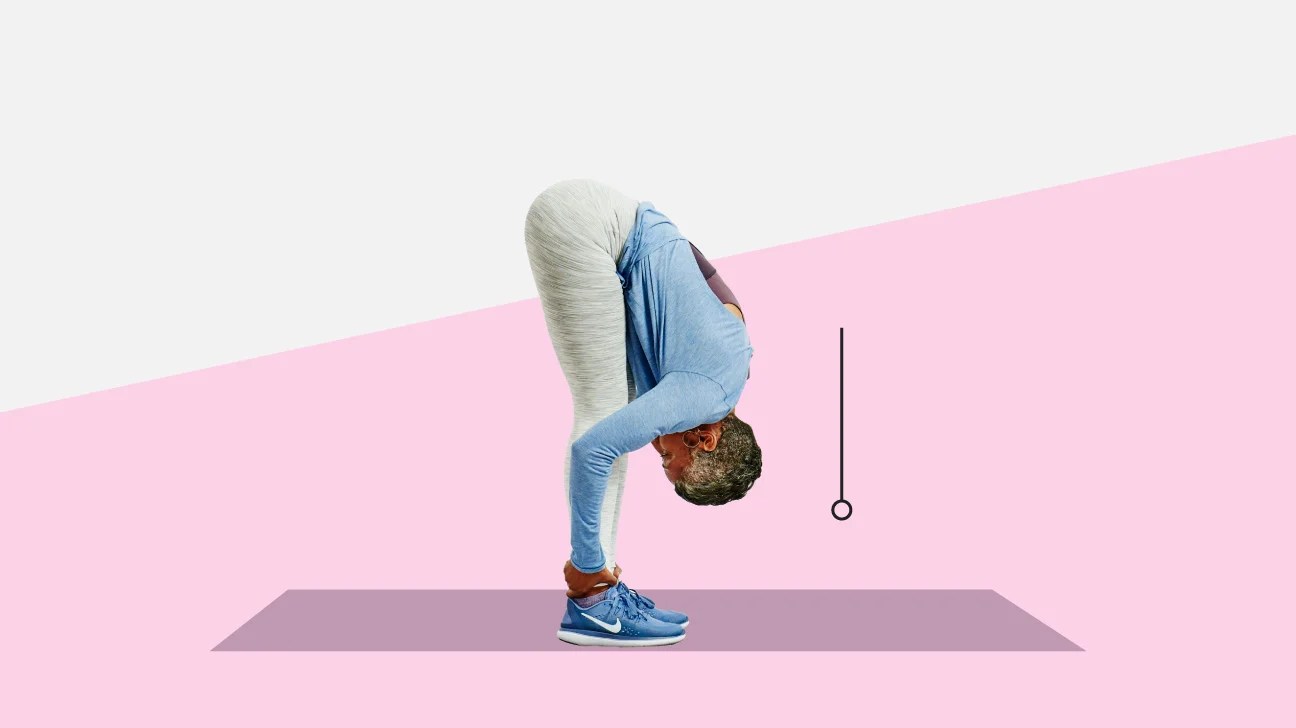
Start with 2 minutes of Child’s Pose and then practice 30-second intervals of Standing Forward Fold for 4 minutes. This pose deeply stretches the hamstrings, stretches the hips, and can help release any tension in the neck and shoulders.
How to do Standing Forward Fold:
- Start with your feet hips-distance apart and bend at the knees to support your body.
- Exhale as you bend forward at the hips, lengthening the front of your torso.
- Bend your elbows and hold on to each elbow with the opposite hand. Let the crown of your head hang down. Press your heels into the floor as you lift your sit bones toward the ceiling.
- Pull your shoulders away from your ears and drop your head and neck.
- Lengthen your legs until you feel a stretch in the hamstring muscles. Work on engaging your quadriceps to help your hamstring muscles release.
- Release deeper into the pose with each exhalation. Let your head hang as you feel the tension roll out of your shoulders and neck.
Day 4: Add Cat-Cow
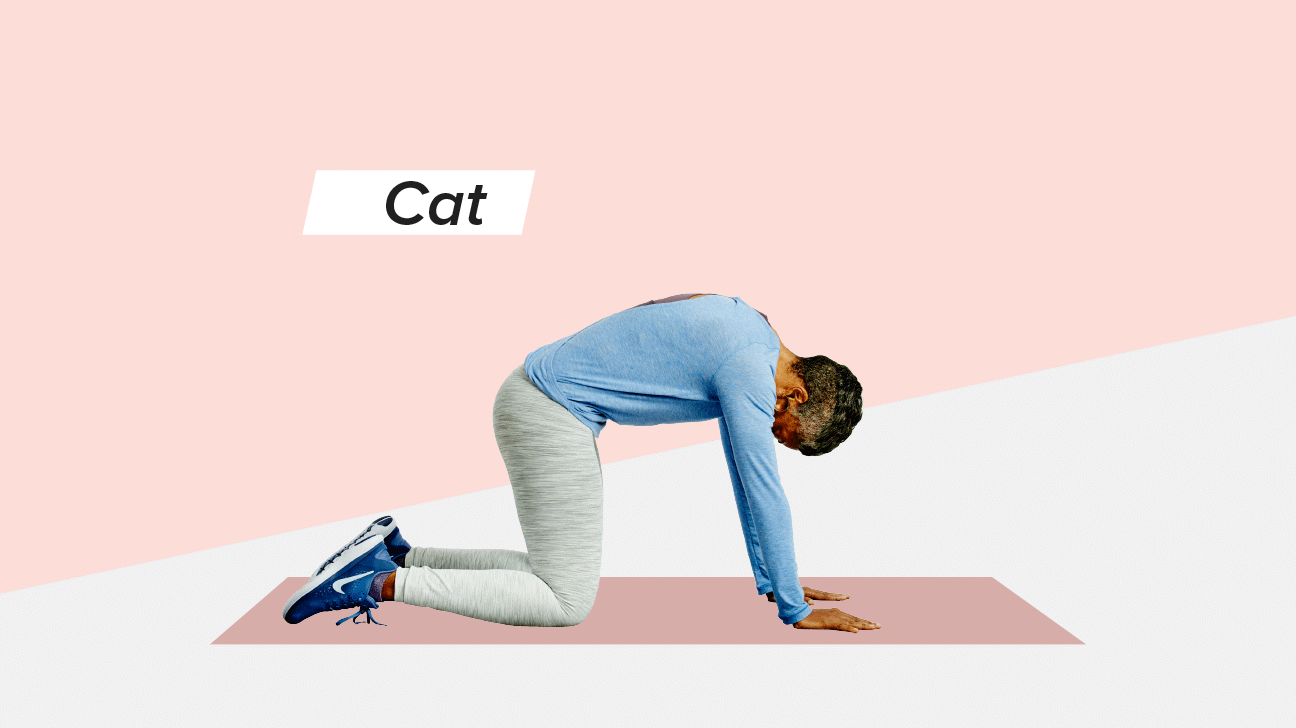
Follow this stretch sequence in the morning and at night: Hold the active Child’s Pose for 1 minute and the Standing Forward Fold for 2 minutes. Then, do Cat-Cow for 5 minutes. This movement sequence will help increase spinal awareness, which is a large part of less-than-perfect posture.
How to do Cat-Cow:
- Start on all fours. Your wrists should be stacked under the elbows which are stacked under the shoulders. Keep your fingers spread against the ground for increased stability and keep your neck neutral.
- Begin the cat phase: As you exhale, tuck your tailbone under using your abdominal muscles to push your spine toward the ceiling, making the shape of a Halloween cat. Lengthen your neck and allow your head to reach toward your chest so that your ears come down by the biceps.
- On the out breathe, “swoop and scoop” the pelvis into the Cow position so that your belly is dropped toward the floor. Lift your chin and chest and gaze up toward the ceiling. Draw your shoulders away from your ears.
Day 5: Add chest stretch
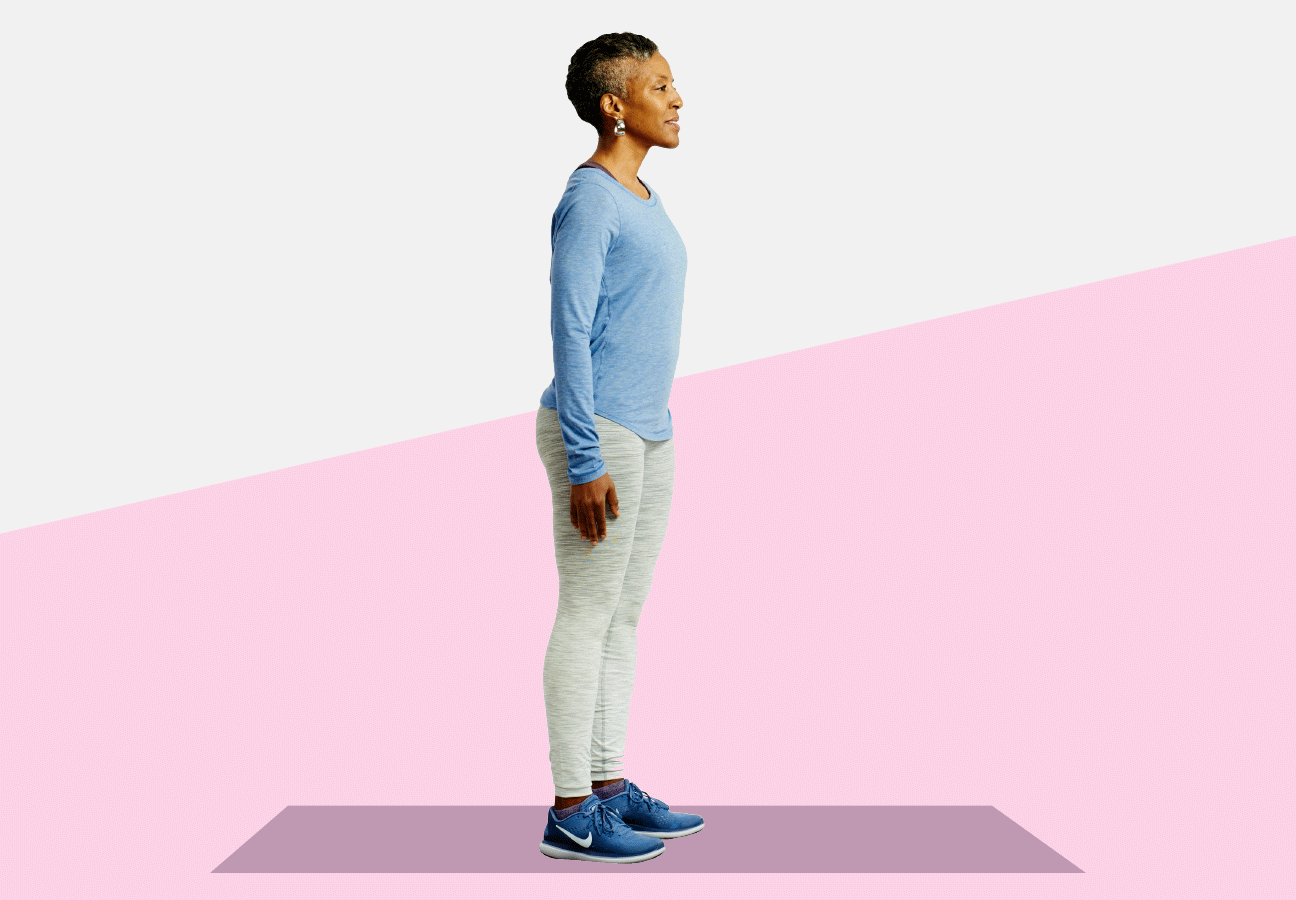
Hold active Child’s Pose for 1 minute, Standing Forward Fold for 2 minutes, and Cat-Cow for 2 minutes. Add 2 minutes of a chest stretch. This is the inverse of how we normally sit at work, so it can help reverse poor alignment and ward off back pain. Do this morning and night.
How to do it:
- Start by standing. If you have joint pain, sit on your butt with your legs stretched out in front of you.
- Reach your arms behind you and interlace your fingers below your lower back. If your arms don’t reach, use a small towel or PVC pipe instead.
- Keep your head neutral and your eyes set straight ahead.
- Then, when you’re ready, begin to lift your chest so that your entire trunk elongates toward the ceiling and reach your hands back toward the floor.
- Hold this pose for 5 breaths, then relax and repeat.
Day 6: Add Standing Cat-Cow
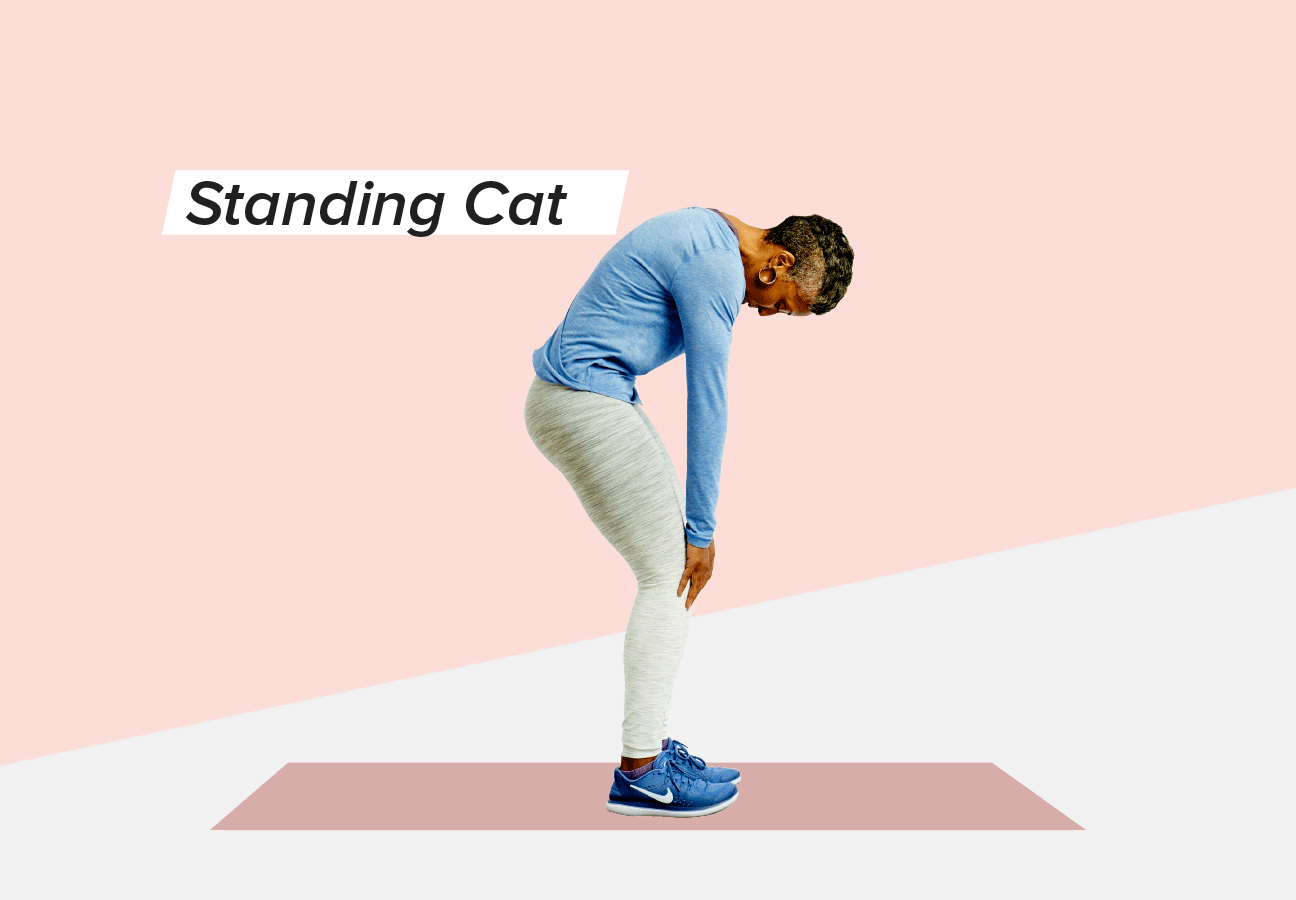
Do 1 minute of active Child’s Pose, 2 minutes of Cat-Cow, and 2 minutes of the chest-opening stretch. Then stand up and do 2 minutes of the Forward Fold before doing 2 minutes of Standing Cat-Cow.
The point of Standing Cat-Cow is to differently activate the back and core muscles, and to help increase awareness of your back in relation to the rest of your body.
How to do Standing Cat-Cow:
- With your legs hip-width apart and knees bent, place your hands either out in front of you or on your thighs for added balance.
- Keeping your legs static, begin the cat (upward) phase. Lengthen your neck and allow your head to reach toward your chest, maintaining alignment with the spine.
- On the out breathe, “swoop and scoop” the pelvis into Cow position.
- Hold each pose for 5 breaths and repeat.
Day 7: Add chest stretches throughout the day
Repeat yesterday’s routine in the morning and night, but also conduct 2–3 minutes of the chest-opening stretch 3 times throughout the day.
Developing the routine
Here’s the Awareness Routine you’ll do every morning for week 2:
Awareness Routine 1:
- 2 minutes Child’s Pose
- 2 minutes Cat-Cow
- 2 minutes Standing Forward Fold (swap the Fold for the chest opener on day 11)
The goal for week 2 is to strengthen your core muscles while maintaining posture and spinal awareness.
Day 8: Build your core
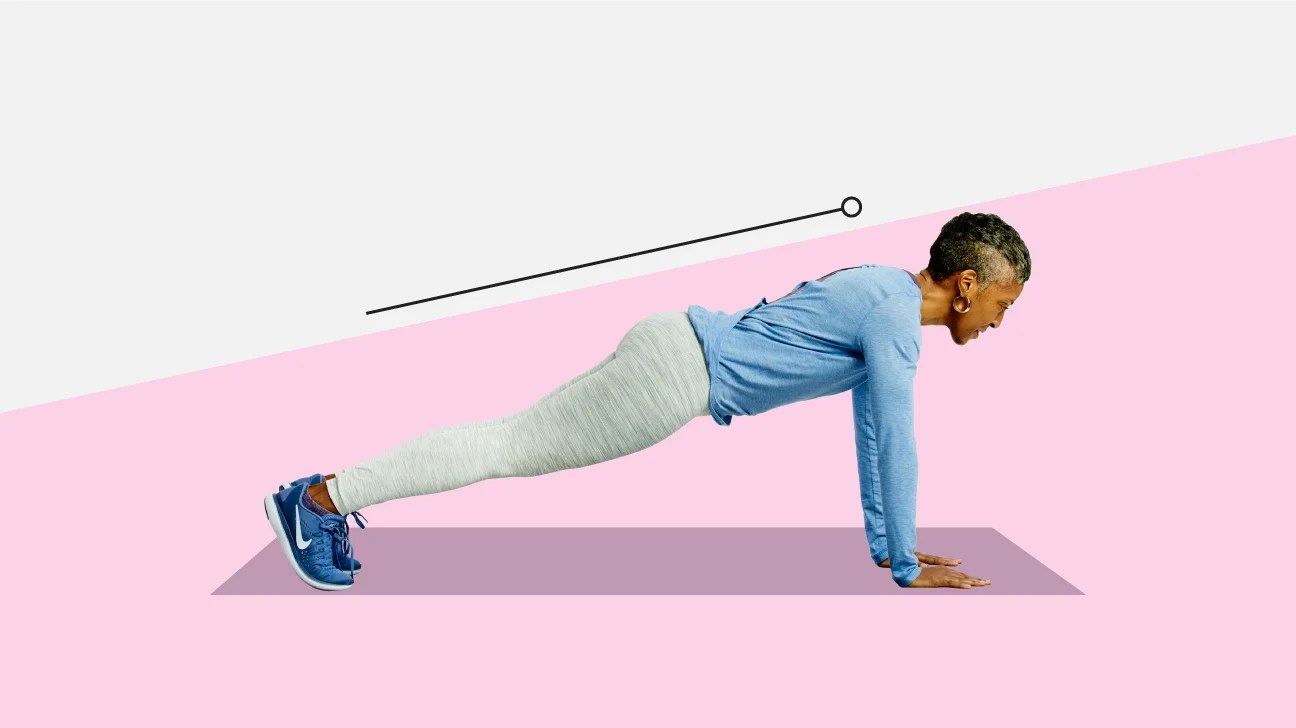
Before you start your Awareness Routine, do 3 to 5 rounds of high plank (one round equals 10 breaths).
The high plank requires awareness of the spinal position as well as engagement of the abdominal muscles, both of which are vital for encouraging posture corrections.
How to do high plank:
- Start in a pushup position, with your arms straight. Press back through your heels so that the backs of your legs are active, too.
- With your elbows underneath your shoulders, create space between your shoulders and ears so that there’s a slight stretch. Make sure your chest isn’t sinking and keep your shoulder blades back.
- Do 3–5 rounds of 10 breaths, counting your breaths.
Day 9: Strengthen your back
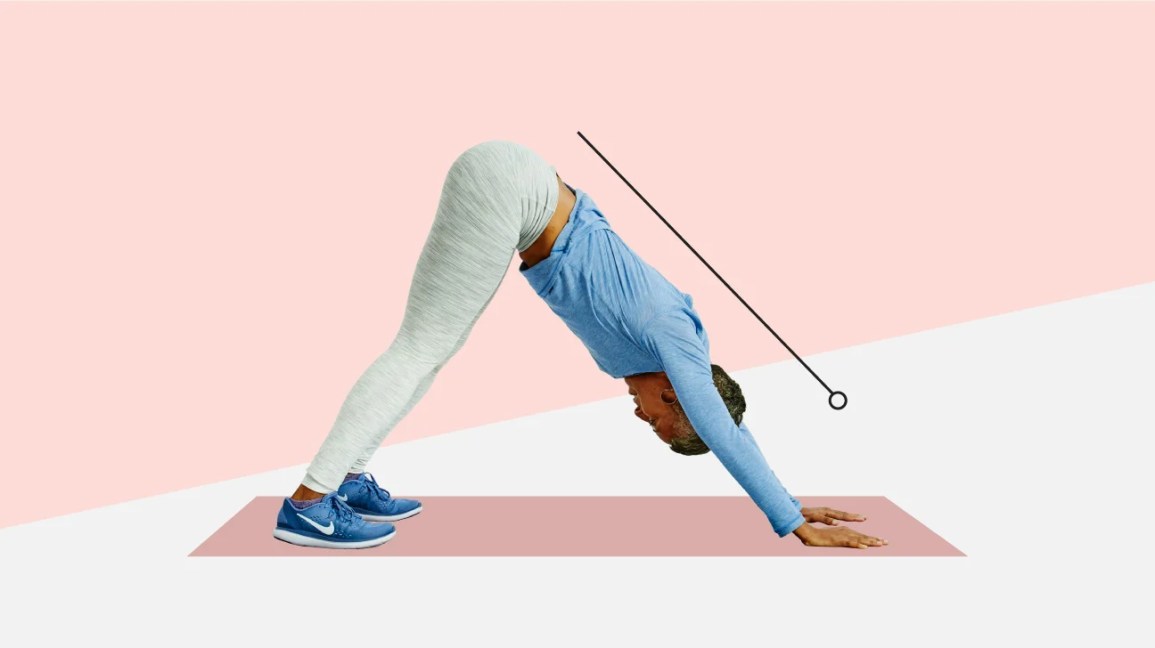
Today, end the Awareness Routine with 5 sets of Downward-Facing Dog (holding for 3 deep breaths).
Downward-Facing Dog is useful for opening the anterior chest wall and shoulders that are so often rounded with excessive desk work.
How to do it:
- Begin on all fours.
- Tuck your toes and lift your hips high, toward the ceiling.
- Reach your heels back toward the mat without allowing them to plank on the ground. Drop your head so that your neck is long.
- As you stay here, make sure that your wrist creases stay parallel to the front edge of the mat. To alleviate the pressure on your wrists, press into the knuckles of your forefinger and thumbs.
- Breathe here.
Day 10: Loosen tight hips
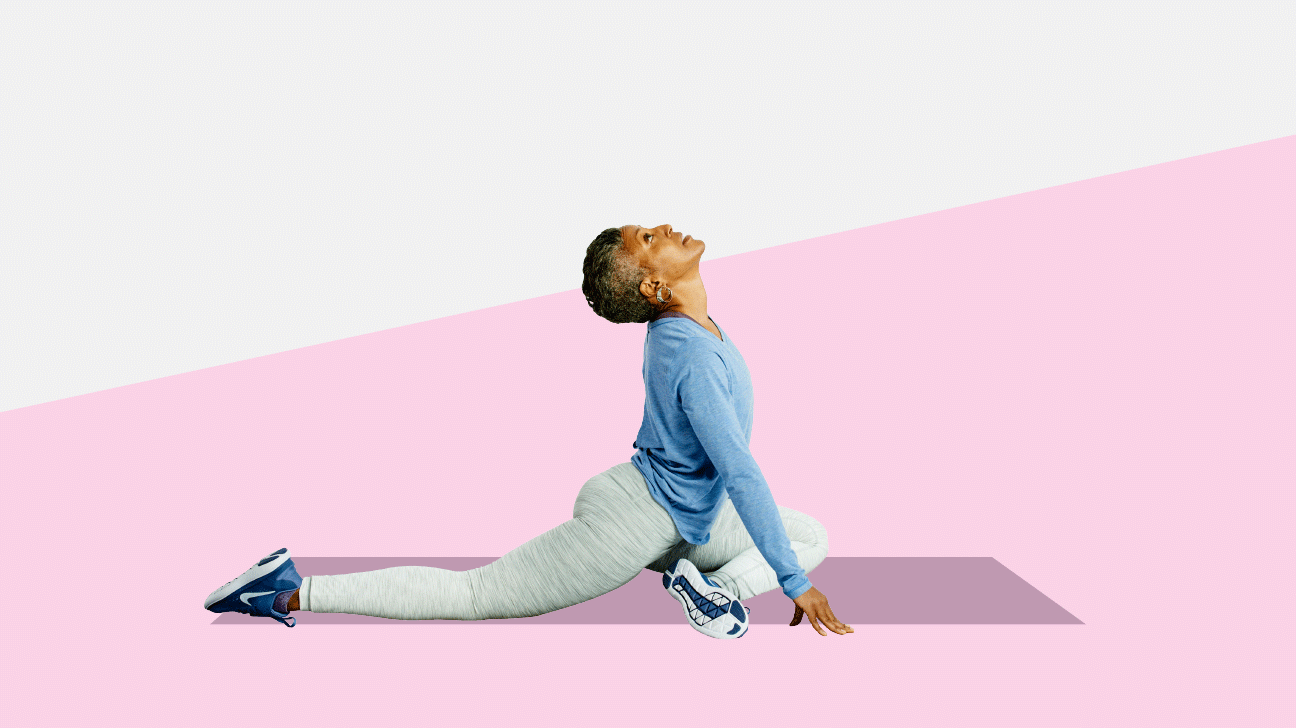
Finish the Awareness Routine with 5 minutes doing Pigeon Pose. This pose helps loosen tight hips and releases tension in the back of the spine and glutes.
How to do Pigeon Pose:
- Begin in Downward-Facing Dog.
- Step both feet together and bring your right knee forward between your hands so that your outer right leg is resting on the mat.
- Make sure your left hip is always pointing down toward the mat. If it begins opening up toward the ceiling, draw your right foot closer to your body.
- Stay here with your hands resting on your right leg or walk your hands out in front of you, allowing your torso to rest over your right knee. Hold here.
- Breathe into any areas of tightness and tension for 3–5 breaths, or about 30 seconds.
- Then place your hands on the mat in front of you, tuck your left toes, and step your right foot back. You’ll now be back in Downward-Facing Dog again.
- Step your left foot forward and repeat Pigeon on the left side.
Day 11: Maintain back awareness
Today, swap the Standing Forward Fold out of your Awareness Routine for the chest opener. Then, when you get to work, set a “movement” reminder alarm to go off on your phone every 20 minutes.
Each time the alarm goes off on your phone, stand up and do 30 seconds to 1 minute of Standing Cat-Cow.
Day 12: Double up on core strength
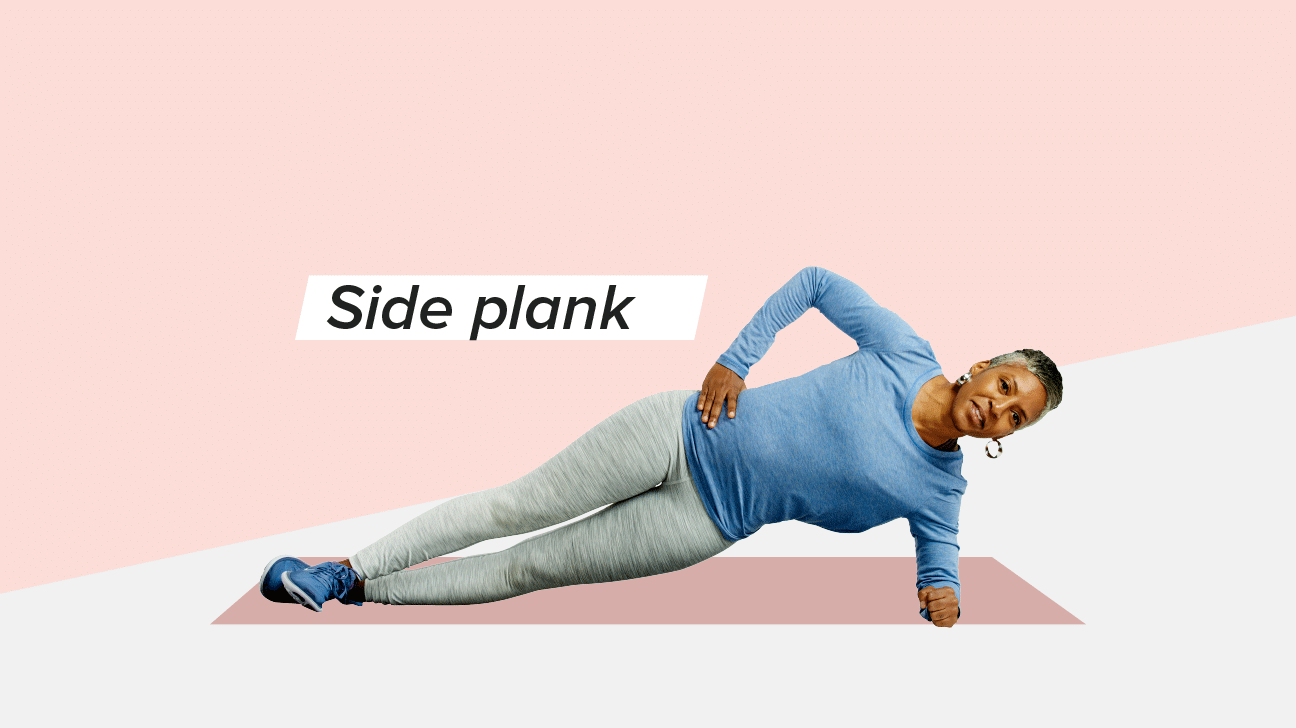
Plan for a 20-minute workout today — including an extra minute of the Pigeon Pose, if your hips are tight. After you’re done, do 10–12 reps of the side plank, hip up, and twists 3 times.
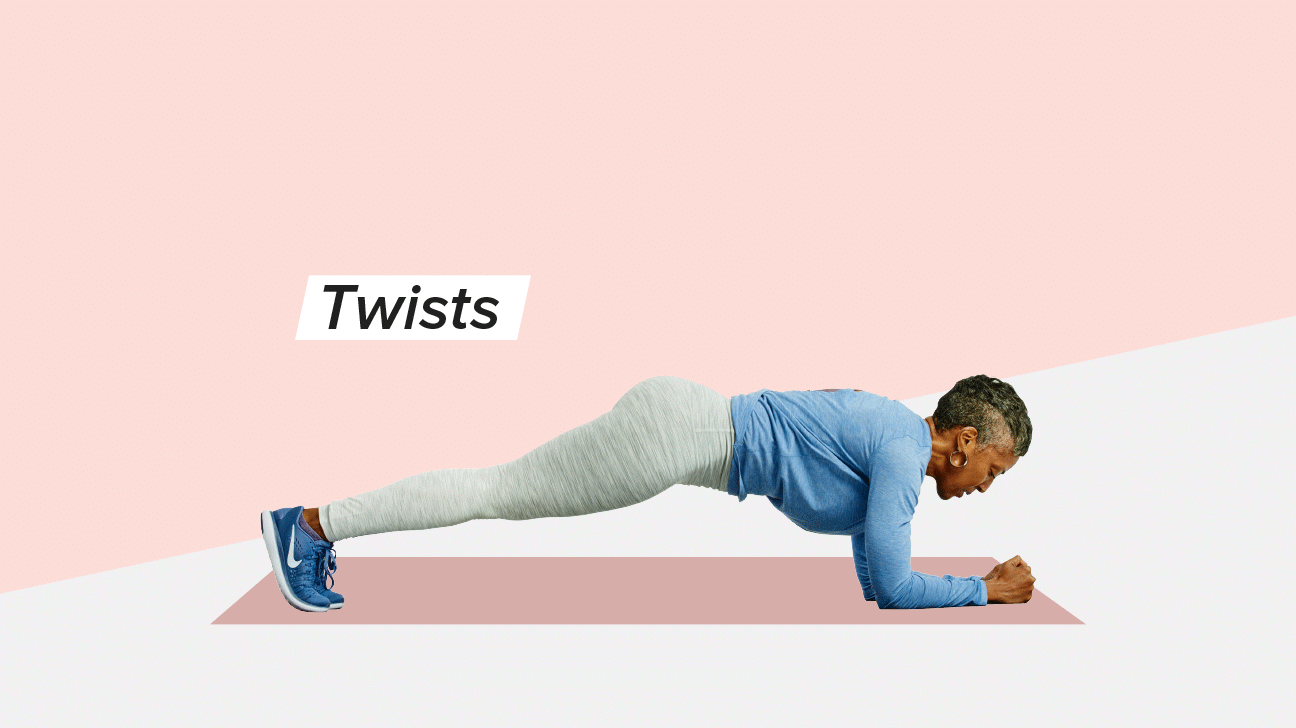
Strong abs will help support your back so that your back muscles aren’t compensating for your body’s efforts to maintain proper posture.
Day 13: Counteract work posture
Make time for the Awareness Routine in the morning and at night. Then, during the day, do 2 minutes of chest- and hip-opening stretches. Ideally, you’ll do chest and hip stretches every 2 hours to counteract work posture and keep your upper body alert and aligned.
How to do it:
- Start on one knee with your opposite foot planted in front of you. Make sure your legs are far enough apart that your back leg can be lengthened while your front knee remains stacked directly over your ankle.
- Place your hands on your front knee and tuck your tailbone slightly toward the floor in order to activate your glutes.
- When you’re ready to begin, release the hip of your back leg forward and down toward the floor.
- Clasp your hands behind your back and reach your arms down toward the back of your back knee, keeping your arms as straight as possible.
- Lift your heart to open your chest.
- Hold for 3 to 5 breaths. Repeat on the opposite side.
Day 14: Start standing at work
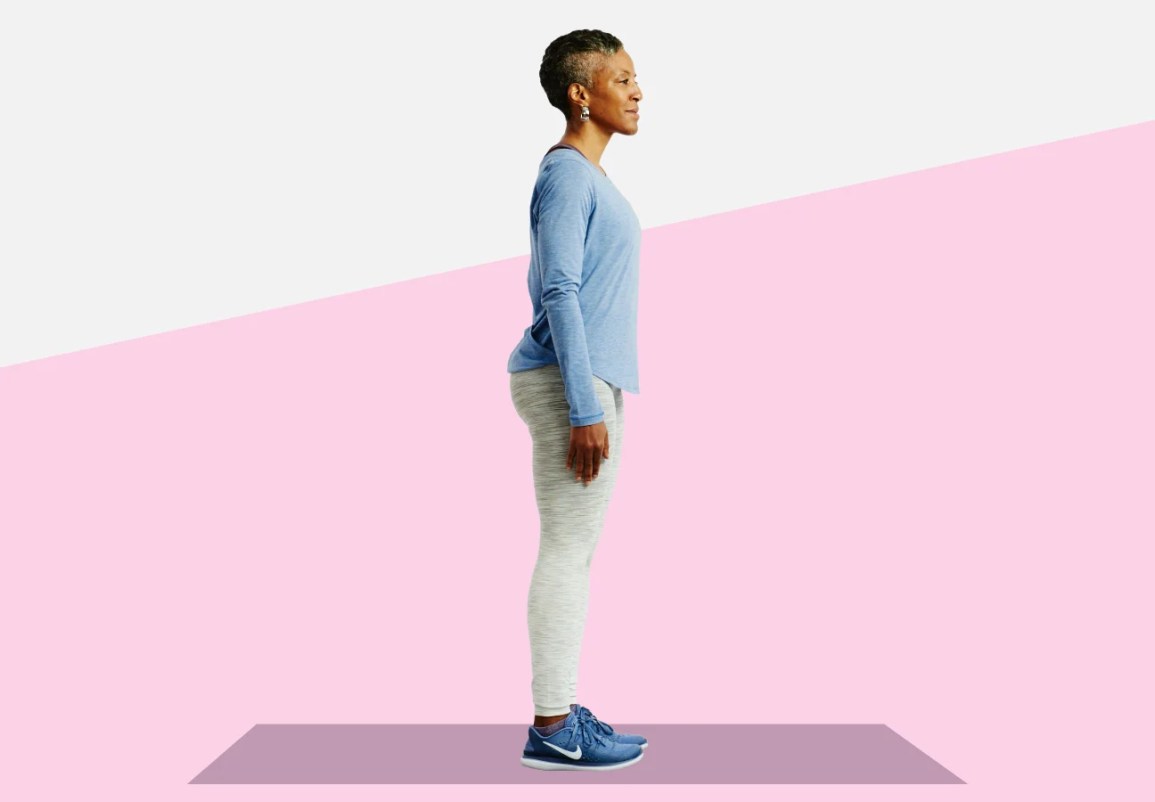
Move your laptop or computer to a standing desk or counter. You can also eat lunch and take conference calls or meetings standing up. Another option is to spend 15 minutes of every hour standing.
If you don’t have a standing desk or high counter in your office, stack books or a crate on top of your desk to add height.
Making small adjustments
Here’s the Awareness Routine you’ll do every morning of week 3:
Awareness Routine 2:
- 2 minutes Child’s Pose
- 1 minute Cat-Cow
- 1 minute pigeon pose
- 1 minute thoracic spine rotation
Do this routine every morning and complete other body goals throughout the day.
Day 15: Reduce stiffness in your lower back
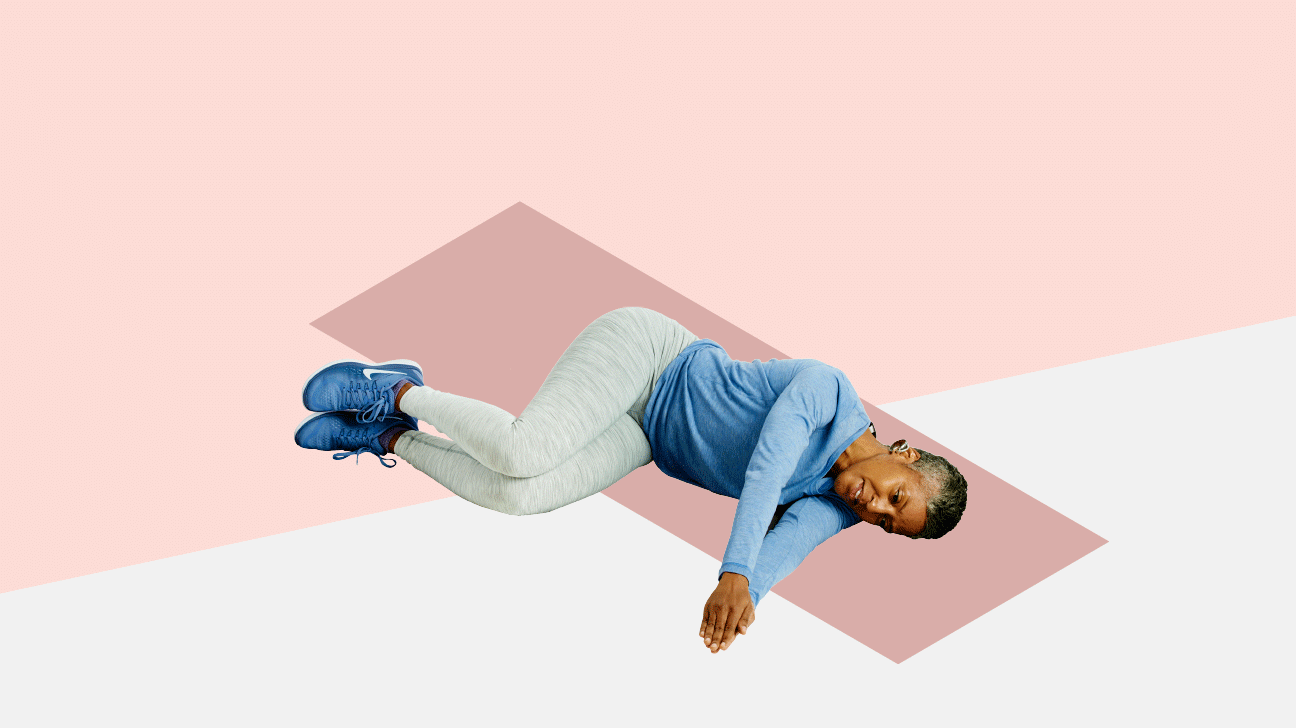
At night, spend 5 minutes doing the thoracic spine rotation exercise. This pose helps improve mobility in your torso and reduces stiffness in the mid-to-lower back.
How to do it:
- Start out lying on your right side with your fingers spread slightly.
- Place your left hand behind your head, but keep your right hand outstretched on the ground in front of you with your fingers spread.
- Rotate your left elbow to the sky while exhaling, stretching the front of your torso, and hold for one deep breath, in and out.
- Return to the starting position and repeat for 5–10 breaths.
- Switch arms and repeat.
Day 16: Move every 20 minutes
At work, set a “movement” reminder alarm to go off on your phone every 20 minutes. Each time the alarm goes off, stand up and stretch for 30 seconds.
Day 17: Try a beginner yoga class
Beginner yoga classes tend to include a lot of poses that can help improve posture such as Camel, Child’s Pose, Cat-Cow, Downward-Facing Dog, Pigeon, and other movements that you haven’t yet done as part of this guide, such as Mountain Pose, Bow Pose, and Plow Pose.
Day 18: Fire up your glutes
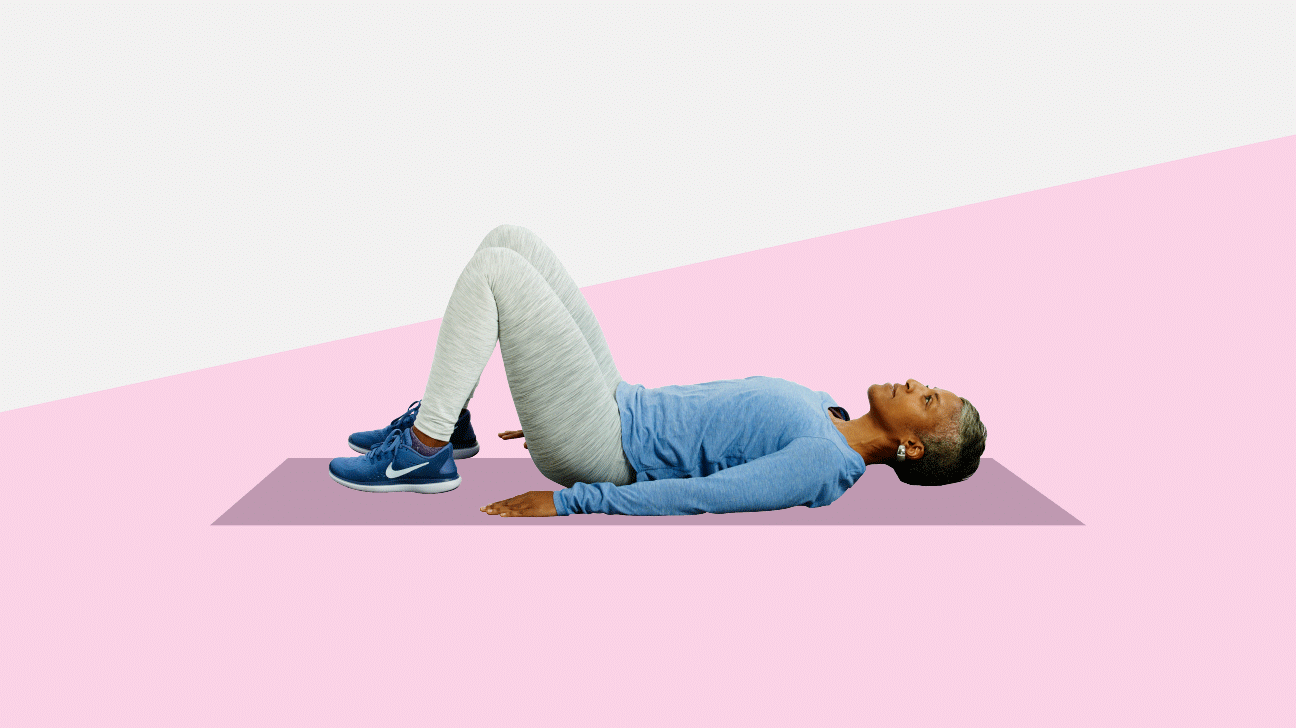
Today is about counteracting inactive glutes. When your glutes shut down, it can impact your hips and lead to poor posture.
So, set a phone alarm for every hour and every time the alarm goes off, do 30 seconds of isometric glute squeezes. (You can do these sitting in your seat too.) Hold this contraction for 10 seconds and then release. Repeat for 1 minute.
These isometric squeezes will help ensure that your glute muscles are firing properly.
Day 19: Tune into your sitting posture
For the whole day, set a phone alarm for every 20 minutes. Every time the alarm goes off, check in on your sitting posture.
Keep an eye on
- your feet, which should be placed on the ground
- your shoulders, which should be upright
- your neck, which should be neutral
- your sitting position, which should be upright, tall, and comfortable
Checking in with yourself and adjusting your posture accordingly can help reform neurological patterns. Try to avoid the following:
How to avoid poor posture
- Don’t cross your legs.
- Don’t slouch or jut your neck forward.
- Don’t bend over at the waist.
Day 20: Hold your cell phone at eye level when you use it
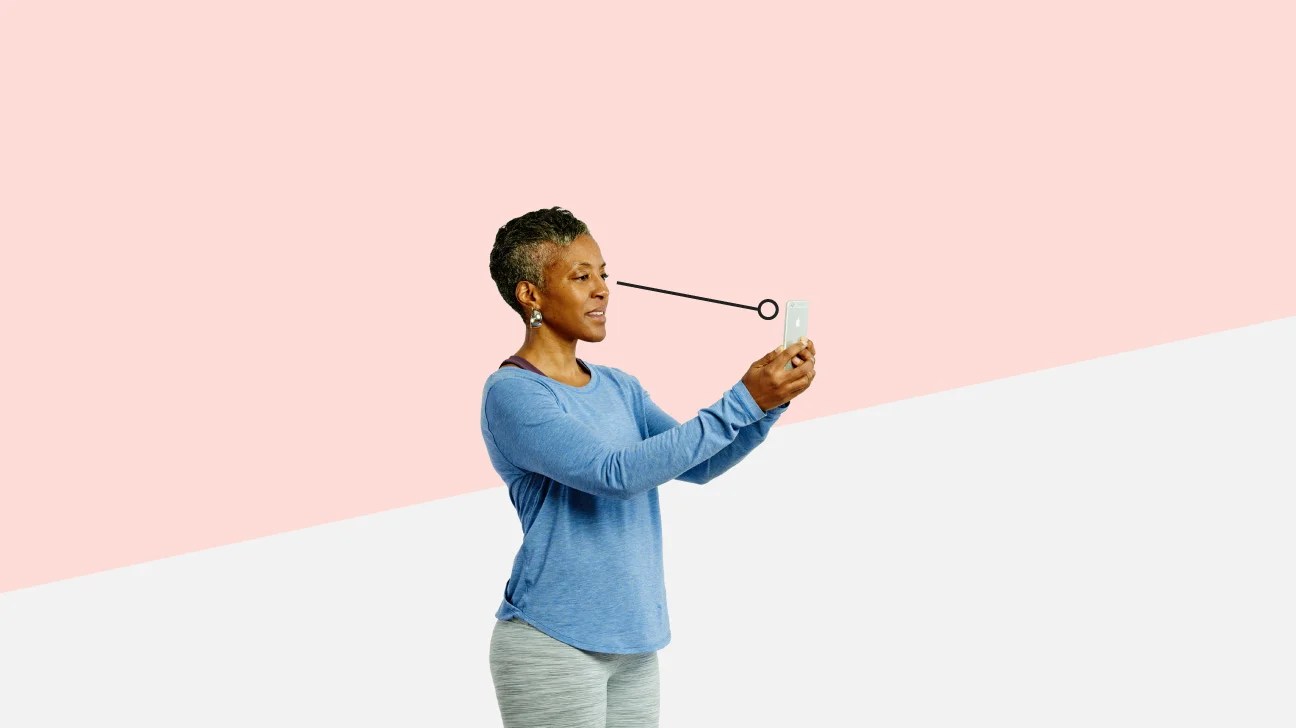
ResearchTrusted Source has shown that over time, looking down at our phones can exacerbate “text neck” or a neck that’s jutted forward. They found that even the slightest tilt of your head, like 15 degrees, can make your 10-pound head feel like 27 pounds.
Truly poor posture can turn our heads into 60-pound weights, increasing risk of early wear and tear to your spine.
Day 21: Repeat day 10
Add 5 minutes of Pigeon Pose at the end of your Awareness Routine for week 1. Bonus points: Because stress can increase aches and pains in the body, do one thing that helps you feel less stressed.
Day 22: Maintain your core strength
Begin the morning and night with 6 minutes of Child’s Pose, Cat-Cow, and Pigeon Pose. At the end of the day, repeat the plank workout regimen of day 12. However, this time, complete 4 sets instead of 3.
Strengthening your body
This week is about maintaining the strength and muscle memory you’ve built over the past few weeks. You’ll be practicing workout routines from the previous weeks but increasing the number of sets.
Day 23: Strengthen your glutes
Set a phone alarm for every hour. Every time the alarm goes off, do 30 seconds of isometric glute squeezes. Hold this contraction for 10 seconds and then release. Repeat for 1 minute.
Day 24: Strengthen your shoulders and back
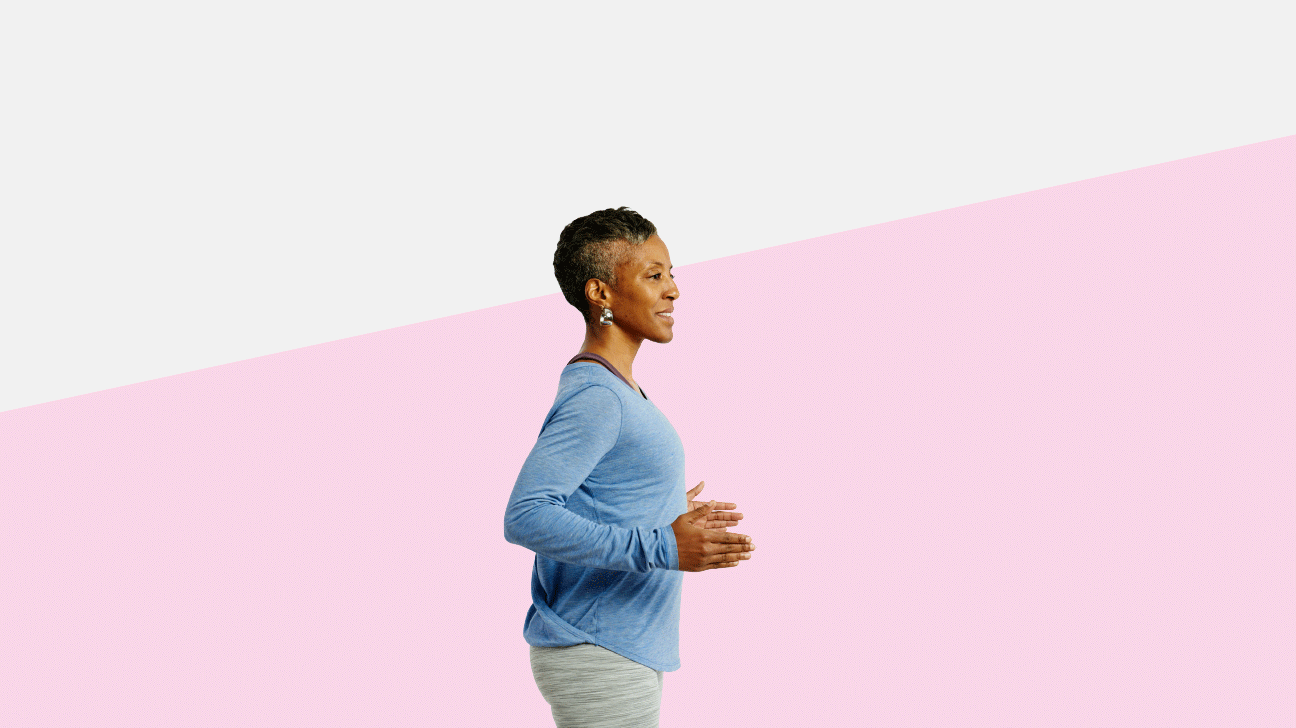
Set a phone alarm for every hour. Every time the alarm goes off, do 10 seconds of isometric rows in your seat. These isometric rows work your entire shoulder girdle, rhomboids, and crucial postural muscles, which help improve posture.
How to do an isometric row:
- Sit up straight and then drive your elbow into the seat behind you by squeezing your shoulder blades together.
- Hold this contraction for 10 seconds and then release.
- Repeat for 1 minute.
Day 25: Go to another yoga class
If you didn’t like the class you went to on day 17, try a beginner yoga class at a new studio. If you’re a first timer, most studios will offer you a discount — or better yet, let you take your first class for free!
Day 26: Work on core strength and flexibility
Complete 5 sets of plank workouts from day 12 (instead of 3). After the workout regimen, do 3–5 minutes of thoracic spine rotation and chest- and hip-opener stretches.
Day 27: Strengthen your glutes
Do the Awareness Routine for 5–6 minutes. If your abdominal muscles are sore from yesterday’s abdominal workout, spend extra time doing Cat-Cow to help stretch the muscles. When you get to work, repeat the isometric glute contractions throughout the day, every hour for 30 seconds.
Day 28: Spend 35 percent of your workday standing

Aim to stand for 35 percent of your workday. Bonus points: When you’re in the kitchen, try cutting vegetables and cooking while looking straight ahead as opposed to hunched over the oven or cutting board.
Day 29: Become more aware of your posture
Relax and stand against the wall and take a picture. Look and see if your natural position has improved since day 19. Keep your progress in mind as you move throughout the day.
Day 30: Spend 50 percent of your workday standing

Stand for 50 percent of your workday and at the end of the day, evaluate how it felt. Look into your company’s standing desk policy or look at investing in one for yourself at your at-home office.
If you feel that 30 days wasn’t enough time to readjust your posture, go back to day 16 and repeat the last 2 weeks.
Take before and after photos for proof
“Thirty days can make a real difference in improving posture, because research shows that it takes 3 to 8 weeks to establish a routine. This guide will help you establish a morning, night, and sitting routine that benefits your posture and body as a whole,” says Marina Mangano, founder of Chiro Yoga Flow.
To really check in on your progress, remember to take photos on the first and last day for evidence.
At the end of these 30 days, your postural muscles should have started to build muscle memory.
You should feel more confident and aware of how your back is positioned during work hours, at home, and throughout the day.


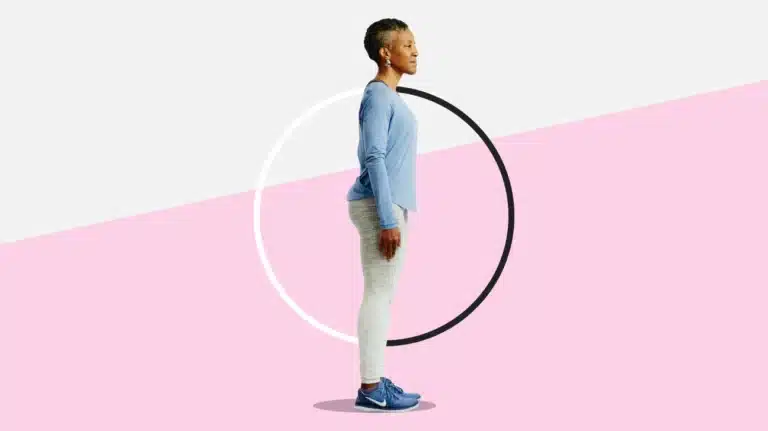
0 Comments